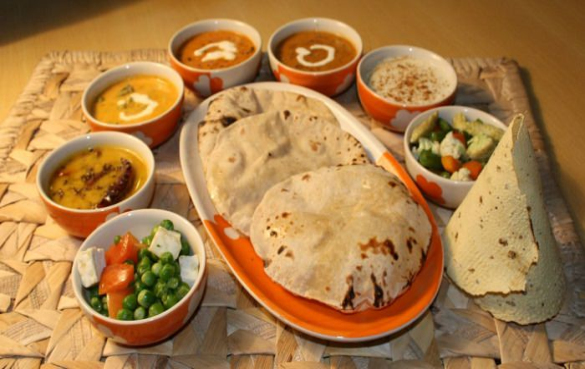Indonesian cuisine is diverse, with over 17,000 islands and numerous ethnic groups contributing to its rich culinary heritage. While it shares some similarities with other Southeast Asian cuisines, such as the use of rice, noodles, and fresh herbs, it also has some distinct flavor profiles and characteristics:
- Spices: Indonesian cuisine is known for its bold and complex spice mixtures. It uses a variety of spices, such as nutmeg, cloves, and cinnamon, which were historically traded throughout the archipelago. Other spices, like galangal, turmeric, and kaffir lime leaves, are also widely used.
- Sambal: A spicy chili paste or sauce made from a combination of chilies, garlic, shallots, and other ingredients, sambal is a key flavoring element in many Indonesian dishes. There are numerous regional variations of sambal, showcasing the diversity of Indonesian cuisine.
- Sweet soy sauce: Kecap manis, a sweet, thick soy sauce, is a popular ingredient in Indonesian cooking, used for marinating, glazing, and stir-frying. The sweetness of kecap manis distinguishes Indonesian dishes from other Southeast Asian cuisines, which often use fish sauce or regular soy sauce as a primary seasoning.
- Coconut: Indonesian cuisine features coconut in various forms, including coconut milk, grated coconut, and coconut oil. This imparts a rich, creamy taste to many dishes, like rendang, curries, and desserts.
- Peanut sauce: A popular condiment in Indonesian cuisine, peanut sauce is made from ground peanuts, tamarind, palm sugar, and other ingredients. It is often used as a dipping sauce for satay or as a dressing for gado-gado, a vegetable salad.
- Fermented ingredients: Indonesian cuisine uses various fermented ingredients, such as tempeh (fermented soybean cake), oncom (fermented peanut cake), and terasi (fermented shrimp paste). These ingredients add depth and umami to Indonesian dishes, setting them apart from other Southeast Asian cuisines.
- Grilling and frying: Indonesian cuisine is known for its grilled dishes, like satay (grilled skewered meat) and ikan bakar (grilled fish), as well as fried dishes like nasi goreng (fried rice) and ayam goreng (fried chicken). These cooking techniques contribute to the distinct flavors of Indonesian dishes.
- Regional diversity: With its vast archipelago and numerous ethnic groups, Indonesian cuisine features a wide variety of regional specialties, from the spicy dishes of Padang to the fragrant, aromatic flavors of Balinese cuisine.
In summary, Indonesian cuisine is characterized by its bold flavors, diverse spices, and unique ingredients. While it shares some commonalities with other Southeast Asian cuisines, its distinctive flavors and cooking techniques set it apart.

Continuing with more aspects that differentiate Indonesian cuisine from other Southeast Asian cuisines:
- Rice varieties: Indonesia is home to various types of rice, which play an essential role in the cuisine. Some regions, such as West Sumatra and Central Java, are known for their unique rice dishes like nasi kuning (turmeric rice) and nasi uduk (coconut rice).
- Banana leaves: Indonesian cuisine frequently uses banana leaves for cooking, serving, and preserving food. Dishes like pepes (fish or meat steamed in banana leaves) and lontong (compressed rice cakes wrapped in banana leaves) showcase the influence of this natural ingredient on Indonesian flavors and presentation.
- Soup and broths: Indonesian cuisine features a wide variety of soups and broths, like soto (a traditional meat soup), rawon (a dark beef soup with keluak nuts), and sayur asem (a sour tamarind vegetable soup). These dishes contrast with the often lighter and clearer broths found in neighboring Southeast Asian countries.
- Snacks and street food: Indonesian street food and snacks are diverse and unique, with options like martabak (stuffed pancake), siomay (fish dumplings with peanut sauce), and pisang goreng (fried bananas) offering a wide range of flavors and textures.
- Desserts: Indonesian desserts are known for their sweet and sometimes unusual combinations. Examples include es teler (a fruit cocktail with coconut, avocado, and jackfruit), klepon (sweet rice balls filled with palm sugar and covered in grated coconut), and bubur ketan hitam (black sticky rice porridge with coconut milk).
- Coffee culture: Indonesia is one of the world’s largest coffee producers, with regions like Sumatra, Java, and Sulawesi cultivating unique and distinct coffee beans. Indonesian coffee culture is an important aspect of the country’s culinary identity, and kopi luwak (civet coffee) is a particularly famous and unique Indonesian coffee variety.
These additional aspects further highlight the distinct flavors, ingredients, and techniques that set Indonesian cuisine apart from its Southeast Asian neighbors, showcasing the incredible culinary diversity of this island nation.